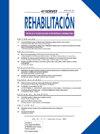Efectividad de las intervenciones de rehabilitación y telerrehabilitación en los pacientes con esclerosis sistémica: revisión de alcance
IF 0.4
Q3 Medicine
引用次数: 0
Abstract
Introduction
Systemic sclerosis (SSc) is an autoimmune condition affecting mainly the skin and musculoskeletal system. Clinically, SSc translates to chronic pain, fatigue and loss of functionality. Rehabilitation interventions aim to improve motor functions, relieve pain, maintain work capacity, and promote functional independence in patients with SSc. However, the effectiveness of different rehabilitation modalities, including telerehabilitation, remains insufficiently described in the literature.
Methods
This review aimed to describe the effectiveness of rehabilitation and telerehabilitation focused on pain, fatigue, function/functionality, and strength in the oral region, hand, and upper limbs. A Scoping Review was carried out following the PRISMA-ScR recommendations. We searched PubMed®, Scopus®, and Embase® for studies from 2010 to 2024, including those that evaluated the effectiveness of rehabilitation and telerehabilitation interventions in SSc.
Results
Our review included 29 articles, mainly from Europe (n = 16, 55%) and Asia (n = 7, 24%). Most were clinical trials (69%) with an average sample size of 58 participants. Hospital-based and combined rehabilitation modalities were the most common. Interventions showed positive effects across outcomes: improvement in pain (41%), fatigue (14%), strength (41%), and function (97%).
Conclusions
Rehabilitation, including telerehabilitation, is effective in improving key symptoms in patients with SSc.Telerehabilitation is an effective and promising alternative for patients with SSc, for the reduction of pain and fatigue.
全身硬化症患者康复和远程康复干预措施的有效性:范围回顾
系统性硬化症(SSc)是一种主要影响皮肤和肌肉骨骼系统的自身免疫性疾病。临床上,SSc转化为慢性疼痛、疲劳和功能丧失。康复干预旨在改善SSc患者的运动功能,缓解疼痛,维持工作能力,促进功能独立性。然而,不同的康复方式,包括远程康复的有效性,在文献中仍然没有充分的描述。方法本综述旨在描述康复和远程康复的有效性,重点关注口腔、手部和上肢的疼痛、疲劳、功能和力量。根据PRISMA-ScR的建议进行了范围审查。我们检索了PubMed®、Scopus®和Embase®,检索了2010年至2024年的研究,包括那些评估SSc康复和远程康复干预有效性的研究。结果纳入29篇文献,主要来自欧洲(n = 16, 55%)和亚洲(n = 7, 24%)。大多数是临床试验(69%),平均样本量为58名参与者。以医院为基础的康复和综合康复方式是最常见的。干预措施显示出积极的结果:疼痛(41%)、疲劳(14%)、力量(41%)和功能(97%)的改善。结论包括远程康复在内的康复治疗可有效改善SSc患者的主要症状。对于SSc患者来说,远程康复是一种有效且有希望的替代方法,可以减轻疼痛和疲劳。
本文章由计算机程序翻译,如有差异,请以英文原文为准。
求助全文
约1分钟内获得全文
求助全文
来源期刊

Rehabilitacion
Medicine-Rehabilitation
CiteScore
0.80
自引率
0.00%
发文量
63
期刊介绍:
La revista que es desde hace más de 40 años la publicación oficial de la Sociedad Española de Rehabilitación y referente de la mayoría de las Sociedades de la Especialidad de los países americanos de habla hispana. Se publican 5 números pluritemáticos al año y uno monográfico sobre un tema del mayor interés y actualidad designado por el consejo de redacción.
 求助内容:
求助内容: 应助结果提醒方式:
应助结果提醒方式:


